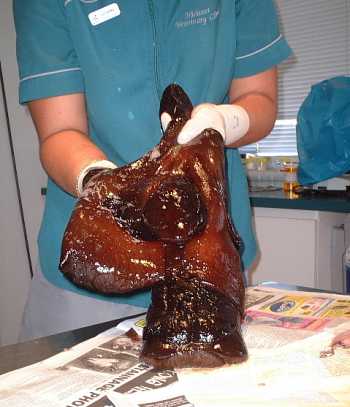
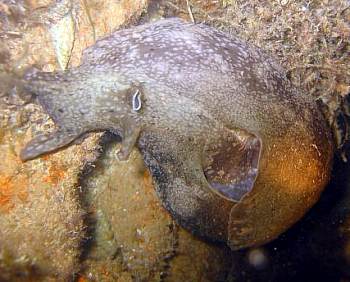
Aplysia gigantea
Sowerby, 1869
Order: ANASPIDEA
Superfamily: APLYSIOIDEA
Family: Aplysiidae
DISTRIBUTION
Common in southwestern corner of Western Australia [Duke of Orleans Bay, east of Esperance to Bluff Point, north of Geraldton].
PHOTO
Upper: animal washed up at Geraldton, Western Australia. See Peter Taylor's message. Photo: Peter Taylor.
Lower: Bicton Baths, Swan River, Western Australia, 20cm long, 30 December 2002, Photo: Masoud Abadi.
This giant Sea Hare can grow to 60cm in length, and are uniformly dark brown or black in colour. They can swim for short periods by flapping their large parapodia. It is considered that this species is restricted in range to the southwestern corner of Western Australia, but it is possible that it is identical to the large swimming Aplysia extraordinaria from eastern Australia. Wells (1986) redescribed A. gigantea but unfortunately did not compare it with A. extraordinaria.
Wells (1986) notes that A. gigantea is found spawning in shallow water during summer and early autumn, and is found most commonly from January to March. During summer, beach strandings of hundreds of animals can be found [see Mass Mortality Page]. He also describes a mating aggregation at Canal Rocks at 21m, March 1985:
" Mating groups of 2,3,5,8 and 17 animals were found, with each animal climbing up the back of the one in front and acting as a male for it. Spawn are typically aplysiid and orange in colour." [See Sea Hare mating Page]. See numerous messages below describing Sea Hares washing up on beaches and poisoning dogs who lick or eat them.
There is some problem with the identity of this species because it was first described from the shell alone, the locality accompanying the shells - "Swan River", being equivalent to "Western Australia" at the time. The size of this species differentiates it from all other species known from Wstern Australia. Unfortunately the original description and illustration (Sowerby in Reeve, 1869) gives no indications of size (other than 'large') and their is no scale on the accompanying plates. Presumably the aplysiid shells in Reeve are drawn to the same scale which would make the shells of A. gigantea at least 3 times the size of most other species of Aplysia illustrated. Surprisingly neither Wells (1986) nor Eales (1960) illustrate or describe the type specimen shells which are held at the British Museum.
References:
• Eales, N.B. (1960) Revision of the world species of Aplysia (Gastropoda, Opisthobranchia). Bulletin of the British Museum (Natural History). Zoology, 5(10): 1-404.
• Sowerby, G.B. (1869) Monograph of the Genus Aplysia Plates 1-10. [IN] Reeve, L.A., (1869) Conchologia Iconica Vol, 17. Reeve: London.
• Wells, F. E. (1986) A redescription of the sea hare Aplysia gigantea Sowerby, 1869. Journal of the malacological Society of Australia, 7(3-4): 173-180.
Rudman, W.B., 2002 (March 5) Aplysia gigantea Sowerby, 1869. [In] Sea Slug Forum. Australian Museum, Sydney. Available from http://www.seaslugforum.net/find/aplygiga
Related messages
Swimming Sea Hare from Western Australia
May 5, 2010
From: Stephen Clifford
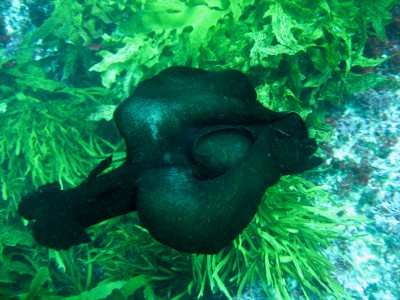
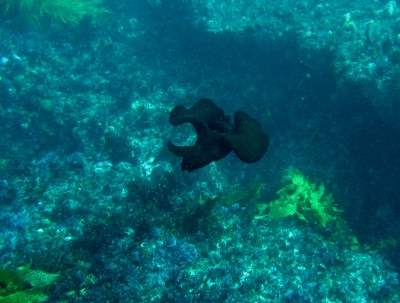
I spotted what appeared to be a pure black creature that looked like a nudibranch and was moving through the water like a spanish dancer. It was about 45 cm long and did not shy or change course when i approached. I asked a season photographer aboard the dive boat and he was unable to identify what it was. Would like information as to what it actually was and if it has been seen before.
Locality: Daves cave , Rottnest island, 19 mtrs, Western Australia, australia, indian ocean, 25 april 2010, weedy bottom, partial sand patches. Length: 450 mm. Photographer: stephen clifford.
Thanks
Stephen Clifford
stevecliffo@yahoo.com.au
Clifford, S.L., 2010 (May 5) Swimming Sea Hare from Western Australia. [Message in] Sea Slug Forum. Australian Museum, Sydney. Available from http://www.seaslugforum.net/find/23564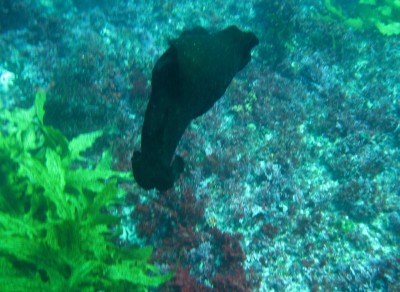
Dear Steve,
This is Sea Hare. Not all species are able to swim but this large Australian species, Aplysia gigantea, certainly can. It is best known in Western Australia for washing up on sandy beaches at the end of its life cycle, where for some reason it can cause inquisitive dogs to go into convulsions. See messages attached to the species Fact Sheet for further information.
Best wishes,
Bill Rudman
Giant Brown Sea Hares at Fremantle, Western Australia
March 3, 2010
From: Joanna Robertson
This morning Greg Rose-Innes and Noreen Robertson were swimming at "Dog Beach" in South Fremantle, Western Australia and saw two healthy 2.5 foot long sea hares swimming along in one meter of clear, still water. This evening there was an exceptionally high tide at the beach - I understand they are mostly seen at high tide around this time of year. Last year we saw 2 dying ones on the beach and a couple of 5 year old kids played with them and put them back into the sea. Afterwards we read that the purple ink the squirt is toxic..? The kids never show any ill side effects, but I understand their slime is poisonous to dogs.
Locality: Dog Beach, South Fremantle, 1 meter, Western Australia, INdian Ocean, 25 February 2010, very calm, clear, turquoise water. Length: 2.5 feet
Joanna Robertson
info@creativecourses.com
Robertson, J., 2010 (Mar 3) Giant Brown Sea Hares at Fremantle, Western Australia. [Message in] Sea Slug Forum. Australian Museum, Sydney. Available from http://www.seaslugforum.net/find/23285Dear Joanna,
The Western Australian Aplysia gigantea is one of the biggest species of Sea Hare. If you look at earlier messages attached to that Fact Sheet you will find quite a discussion on the toxicity of the dying animals - especially to dogs.
As far as I know the source of the toxicity is unknown but it is unlikely to be the purple ink which seems to be a byproduct of digestion associeted with eating red algae. If you go to the General Topics list [top left og page] you will find a section on Sea Hares which has links to many pages on Sea Hare biology, including their ink.
Best wishes,
Bill Rudman
Sea hares at Perth, W. Australia.
February 18, 2010
From: John Gorter
I just threw 3 sea hares back into the water at Floreat Beach, Western Australia. I have never seen these creatures here before. I think we had recently had a high tide. All three were still alive. Two were about 20 cm long and black. The other was smaller and appeared to have pink ?gills.
Locality: Floreat Beach, on beach, Western Australia, Indian Ocean, 13 February 2010, sandy beach. Length: about 20. Photographer: no camera.
Any information appreciated.
John Gorter
City Beach WA
john.gorter@eniaustralia.com.au
Gorter, J., 2010 (Feb 18) Sea hares at Perth, W. Australia.. [Message in] Sea Slug Forum. Australian Museum, Sydney. Available from http://www.seaslugforum.net/find/23232Dear John,
The animals were almost certainly Aplysia gigantea, which washup and die along the beaches of Western Australia, or at least the southern half of WA, every year. Have a look at the species Fact Sheet and the attached messages for more information.
Best wishes,
Bill Rudman
Re: Big Sea slug from Western Australia
March 11, 2009
From: Dawn Skinner

Concerning message #21482:
Hi Suzy,
We walk the same beach and I have been wondering what these creatures are for several years. It has such a strange almost calf liver appearance that contracts when water is put on it ... Finally got a clue through the Environment Centre. One of the marine volunteers looked at the photo and suggested Sea Hare.
There seems to be quite a few more of them than in other years. I found 3 in just one short morning walk recently. Barely a week has gone by over the past few months where I haven't come across at least one. Do you think the death rate has increased this summer?
Locality: Safety Bay, On shore, Western Australia, Indian Ocean, February and March 2009, Sandy Beach. Photographer: Dawn Skinner.
Dawn Skinner
rrc@naragebup.org.au
Skinner, D. M., 2009 (Mar 11) Re: Big Sea slug from Western Australia. [Message in] Sea Slug Forum. Australian Museum, Sydney. Available from http://www.seaslugforum.net/find/22330Dear Dawn,
Your animal is certainly Aplysia gigantea. As you will see from looking at my comments on earlier messages concerning this species, mass strandings seem to be an annual occurrence for this species. In fact many species of Sea Hare around the world exhibit similar strandings which I discuss on separate Fact Sheet. What makes the strandings of A. gigantea particularly noticeable is its large size and its unfortunate ability to poison pet dogs.
It is interesting that you likened it to a calf's liver as a Californian correspondent likened one to a cow's liver [message #7091]. To continue the body parts comparison, another Californian, found what they thought was a heart and suspecting foul play, took it to their local Police Station. Not happy with the police identification of it as a sea slug they wrote to the Forum for assistance [message #2169 ].
Best wishes,
Bill Rudman
Poisonous Sea Hares in Western Australia
February 23, 2009
From: Helen Oates
Concerning message #21482:
Just a Warning...There seems to be a huge amount of sea slugs on the WA coast, especially around Geraldton - that have washed up dead, our friends young dog (9 mths old) died after ingesting or licking the slug.
Locality: Geraldton, Western Australia, Indian Ocean, 22 February 2009, washed up on beach
Helen Oates
hoates13@bigpond.com.au
Oates, H., 2009 (Feb 23) Poisonous Sea Hares in Western Australia. [Message in] Sea Slug Forum. Australian Museum, Sydney. Available from http://www.seaslugforum.net/find/22278Dear Helen,
Thnaks for the message. As you have no doubt read on the Forum this large Western Australian Sea Hare, Aplysia gigantea, has a bad reputation for killing dogs. Different species of Sea Hares wash up at times in many parts of the world, but I know of no other species with has been reported to be so toxic.
Best wishes,
Bill Rudman
Big Sea slug from Western Australia
March 31, 2008
From: Suzy Galloway
Hi ,
I was walking along Safety Bay, Near Rockingham (Perth, Western Australia) and found on the beach a big sea slug. At first I thought it might have been whale blubber because it was covered in sand. I poked it with my sandal because I was scared of it. It kind of bounced back so I rolled it into the ocean again, But it was dead.
The slug would of been about 2 feet long ( 500 mm). I recognised it was a slug in the water because I could see it's eyes (the long bits) and it had a big foot. The colour was dark brown and when in the water a purple colour came out of it, like blood. It was wierd and I didn't even realise we had them here.
Locality: Safety Bay WA, On beach, Australia WA, Indian Ocean, 28 march 2008. Clear blue water but dead on beach. Length: 500 mm.
Sad to see it was dead.
Looked up on internet to see if I could find one and came across this site.
Suzy Galloway
suzy.gall@bigpond.com
Galloway, S., 2008 (Mar 31) Big Sea slug from Western Australia. [Message in] Sea Slug Forum. Australian Museum, Sydney. Available from http://www.seaslugforum.net/find/21482Dear Suzy,
This is a sea hare, the purple ink is a giveaway. It is almost certainly Aplysia gigantea, which is a large species found in Western Australia which often washes up like this in large numbers. If you are not familiar with this website go to the Aplysia gigantea Fact Sheet and read the information there and look at the messages attached at the bottom of the page. Quite a few of them report and discuss them washing up on Western Australian beaches.
Best wishes,
Bill Rudman
Sea Hare poisoning in Western Australia
March 11, 2005
From: Dr Tony Pusey
I am a practicing veterinarian in Margaret River [South west Western Australia] and thought that I should update you on a recent poisoning I had to attend. There is currently a mass mortality of Aplysia gigantea (presumably) at the mouth of the Blackwood River at Augusta. Up to 300 individuals have been counted in one small beach alone. 2 nights ago I was presented with a seizuring dog that had been observed to eat something (unknown) an hour before whilst at the above beach. The dog was in extreme hyperthermia - 41.5 degrees C, extreme panting and extreme muscle fasciculations and tremor. Organophosphate poisoning was possible as the owner had not actually observed what the dog was eating or possibly just licking. There was no response to atropine administration. Seizure severity increased and dog was anaesthetised, the stomach washed (nothing recovered) iv fluids, shock doses of cortisone, and colonic lavage to normalise body temp and gastric lavage with activated charcoal suspension was administered. The dog required anaesthesia for more than 12 hours as each time we attmpted to allow the dog to wake up the seizures and panting would recur. Anaesthesia with pentobarbitone was followed by sedation with diazepam and the dog made an uneventful recovery 36 hours later. I am not sure that the mortalities recorded 3 years ago in Geraldton were from neurological causes or severe gastro-intestinal as I seem to recall. I would certainly appreciate any feedback from other vets (or others) if they have any further thoughts or advice.
Tony Pusey
mrvet@westnet.com.au
Pusey, T., 2005 (Mar 11) Sea Hare poisoning in Western Australia. [Message in] Sea Slug Forum. Australian Museum, Sydney. Available from http://www.seaslugforum.net/find/13320Dear Tony,
In an earlier message [#9237] I mentioned the possiblity of toxic dinoflagellates being involved. I am not an expert in these things but the mixture of gastro-intestinal and neurological symptoms certainly are similar to ciguatera poisoning where people are poisoned by fish contaminated with a toxic species of dinoflagellate. It might be worth checking out ciguatera poisoning symptoms and treatment.
What puzzles me is that mass mortality of Sea Hares is a worldwide phenomenon and yet only in Western Australia have there been reports of dog poisoning.
Best wishes,
Bill Rudman
Poisonous Sea Hares
March 27, 2003
From: Sue Lennard
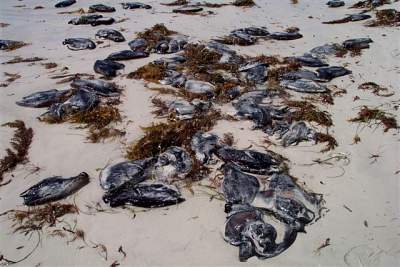
I am one of the women in the local paper's article about cleaning the beach of the Sea Hares in Geraldton, Western Australia ... great idea BUT way beyond the capacity of mere volunteers! Here are a few pix though, can anyone tell me what the difference is between the big black one and the smaller grey/khaki/yellow one (male/female; senior/junior; 2 different species ?)
The enclosed poster was put up on rubbish bins at local beaches.
Sue Lennard.
lennards@geraldton.wa.gov.au
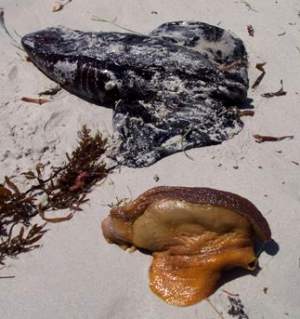
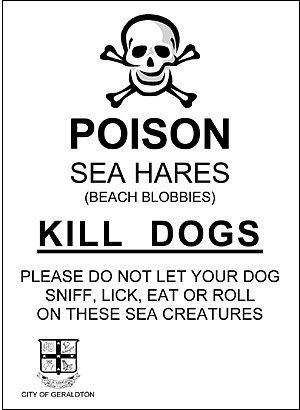
Thanks Sue,
It sad to think of Sea Hares as dead 'beach blobbies'. They are quite different when alive and happy. The only published information I know about this species alive is an article by Fred Wells I mention on the Aplysia gigantea Fact Sheet.
Concerning your question about the two colour 'forms'. It's definitely not a sexual difference as all Sea Hares are hermaphrodite, acting simultaneously as male and female during mating. They sometimes form spectacular mating chains, Fred Wells reporting one 17 animals long. Wells says the animals are uniform dark brown or black in colour, but clearly they can range from a very light brown to very dark brown-black. I would suspect the yellowish animal is just a light colour form of the same species.
This is surely an animal that is crying out for some scientific research. Perhaps your City Council should consider offering a research grant to a university student to undertake research on its biology and natural history, or the chemistry of its skin glands. It need only be a few thousand dollars. Most graduate students are desperate for funds to assist their research projects so this could be a way for your community to find out more about this troublesome visitor to your shores, and at the same time assisting in the education of a young student.
Best wishes,
Bill Rudman
Wilbur recovers from Sea Hare poisoning
March 19, 2003
From: Sandra & Andy Rose
Pleased to report that our dog - Wilbur - is recovering from the effects of his ingestion of part of a sea-slug which had been washed up on a Hardy Inlet, Augusta, beach. Our vet treated him with sedation, a massive antibiotic injection and an anti-inflammatory injection. It was a very unpleasant experience for him judging from the tremors & spasms, rapid eye movements, and inability to walk/control his legs. He is a 30 kg plus dog so his size and the fact that we caught him before he could do much more than taste the slug has probably helped.
Sandra & Andy Rose
alphac@iinet.net.au
Dear Sandra & Andy,
Glad to hear the good news - but it looks like beachcombing in Western Australia is a bit of a health-hazard at present
Bill Rudman.
Sea Hare - toxic to dogs
March 18, 2003
From: Sandra & Andy Rose
Hello,
Our dog has ingested a small quantity of what we think was an Aplysia gigantea. We appear to be experiencing a 'mass mortality' event in Augusta, Western Australia, with huge numbers of these creatures being washed up on beaches and at the top end of the Hardy inlet. Wilbur has been treated by our local veterinarian but we do not know if he will pull through. Unfortunately we were unaware of the toxicity of these creatures to dogs. We will be spreading the word to others.
Sandra & Andy Rose,
Augusta, WA.
alphac@iinet.net.au
Dear Sandra & Andy,
I am very sorry to hear about your dog. I hope he recovers. Thanks for the information which is a valuable addition to our knowledge. All previous incidences of dog-poisoning have occurred in the Geraldton region, so yours from Augusta in the southwestern corner of Western Australia suggests that this is a much more widespread phenomenon than previously thought. I mentioned earlier that I would have expected to have heard of poisonings form the much more densely populated Perth region if the phenomenon was widespread, because there have been many reports over the years of mass strandings of Sea Hares from Perth.
I am sorry I can't offer you any advice, or cure. To my knowledge, nowhere else in Australia, or for that matter the world, has a similar problem, and sea hares certainly wash up like this all around the world.
Best wishes,
Bill Rudman
Sea hares in Western Australia
March 17, 2003
From: Joyce Mort.
Attn W.B.Rudman.
February 24th 2003. On holiday in Kalbarri north of Geraldton, W.A. we came across quite a few creatures which appear to match the description of the SEA HARE which there has been much discussion about. They were apparently stranded on the sandy shore at the mouth of the Murchison River. Dogs exercise regularly on this beach and seemed uninterested in them. I did try returning these large black creatures to the deeper water and though they lifted their snail-like head and moved their mantle, they didn't have much success against the tide.
Joyce Mort,
Bunbury, W.A.
amort@eon.net.au
Thanks Joyce,
Bill Rudman
Dog-poisoning Sea Hares make the news
February 27, 2003
From: Bill Rudman

Here is a news item from the The Geraldton Guardian, the local newspaper in Geraldton, Western Australia. Although misidentified as 'nudibranch' and 'spanish dancer', it illustrates how concerned the local people are about the danger the beached Aplysia gigantea are to their dogs. The article and photo are republished here with the kind permission of the Editor, Charles Jenkinson.
==========================
Call to arms for more beach clean-up efforts
DOZENS of unwelcome visitors were collected by a small group of Geraldton residents in clean-up mode on Sunday. The marine creature nudibranch, also known as ‘the spanish dancer’, had washed ashore at Back Beach. Containing toxins lethal to animals, dead nudibranches on local beaches killed at least five dogs last summer and have claimed the lives of more family pets this year. The painful death two weeks ago of a friend’s faithful companion, from eating a small piece of nudibranch, prompted Judy Teakle and Sue Lennard to organise a clean-up. Seven volunteers using gloves, retrieved nudibranch corpses and placed them in plastic clean-up bags, removing almost one tonne of the creatures from the beach. 'We’ve barely made a mark on it, but at least it’s a start,' Mrs Teakle said. She hopes clean-ups can be organised on other local beaches.
Miss Lennard, a City of Geraldton councillor and co-ordinator of Geraldton Dog Rescue said she had seen too many dogs die painfully from nudibranch toxins. 'The danger is very real and it’s been known for several years, yet nothing is done about it,' she said. 'The city’s response to this situation could at best be described as ‘tardy’. Signs warning of the danger should be erected. I understand that signage options are finally being investigated, but if beaches have to be closed in the meantime, then that should be done immediately.'
The Geraldton Guardian, 19 February 2003
http://www.geraldtonguardian.com.au/archives/19022003/news/19022003news.htm
PHOTO: Dirty work: Sue Lennard and Judy Teakle clear nudibranch corpses from Back Beach.
=======================
Cheers,
Bill Rudman
Re: Dog-poisoning Sea Hares
February 26, 2003
From: Gwyneth Ingham
As a vet in Geraldton, Western Australia we are seeing a seasonal influx of large black/brown/yellow invertebrates which I have always thought were nudibranchs or Sea Hares. We are seeing an increasing number of dogs poisoned by eating or licking these creatures. They exhibit neurological signs and pulmonary oedema. By trial and error and contact with staff of the West Australian Mueum we have developed a good treatment protocol which saves most dogs if we see them early enough. Do you have any suggestions as to species i.d., what the toxin might be, treatment?
Gwyneth Ingham
gwyn@wn.com.au
Dear Gwyneth,
As you'll see from the Fact Sheet, and other messages on this page, the culprit is the Sea Hare Aplysia gigantea. Sea Hares are a major group of the opisthobranchs or sea slugs. They are not nudibranchs, which are a quite separate group of opisthobranchs. Although this species swims, it is not the Spanish Dancer, Hexabranchus sanguineus, which is a dorid nudibranch.
The thing that surprises me about this phenomenon is that different species of Sea Hares are common world-wide, and regularly wash up on beaches [see mass mortality page] but only in the Geraldton region do they seem to affect dogs - and apparently some humans as well. This species is also common around Perth and I have heard of no dog-poisonings down there. Sea Hares are known to store chemical compounds from the algae they feed in their skin for protection. I guess it is possible that there is a red algae in the Geraldton area, which produces some particularly nasty chemicals. Considering this phenomenon has been going on for at least a year it would certainly seem to be something worthy of a research project.
Best wishes,
Bill Rudman
Re: Giant Sea Hares poisoning dogs
February 24, 2003
From: Sharon Wood
Dear Bill,
Thanks for your prompt reply. I will take the digital camera down to the beach and see how well they photograph. They seen to be of the same consistency of the photo taken by vet but was jet-black without any other colour, however we did not turn it over to check other side.
Will get back to you ASAP.
Regards
Sharon
bayglass@bigpond.com.au
Wood, S., 2003 (Feb 24) Re: Giant Sea Hares poisoning dogs. [Message in] Sea Slug Forum. Australian Museum, Sydney. Available from http://www.seaslugforum.net/find/9271Re: Giant Sea Hare poisoning dogs!
February 21, 2003
From: Sharon Wood
I have just read about "Sea Hares" killing dogs at Geraldton, Western Australia. This was on the news several months ago. We have seen quite a lot of these washed up on the beach in Jurien Bay W.A (about 160kms south of Geraldton) since hearing about the affect this species may have on dogs we have kept an eye out. Yesterday [18 Feb 2003] whilst walking the dog a "sea hare" (I think) was washed up and concealed amongst the seaweed, my partner made a lunge for the dog as it was about to walk on the black mass. His wrist touched the animal and today he has red, raised welts on his wrist. Is there any information on these animals being toxic to humans as well as dogs?
Sharon Wood
bayglass@bigpond.com.au
Dear Sharon,
The first report on the Forum of dogs being poisoned by these 'washed up' Sea Hares was from Peter Taylor in June last year. Kim Trotter's message yesterday, suggests that this is either another mass mortality event or perhaps these deaths have been going on for 8 months.
The first difficulty in answering your question is not being sure of the identity of your 'black mass'. I guess it is reasonable to assume it one of these Sea Hares, but there is a possibility it is something else. Your description of it being washed up with sea weed suggests you have had rough weather, and plants and animals have been dislodged from the sea bed and washed ashore. If so, it is possible that your black mass is a sponge, some of which are quite nasty to touch and would cause red welts and stinging. It could also be some sort of jelly fish. Why I am suggesting some alternatives is that I have never heard of humans being affected by Sea Hares in this way - mind you it is also very unusual for dogs to be poisoned.
If your black mass was a Sea Hare, the only suggestion I can make is that there are some toxic dinoflagellates in the water which are on the skin of the Sea Hares. Dinoflagellates are small single-celled plants. They are very common in the sea and are usually a very important food for many filter feeding animals. Sometimes however there are 'blooms', or population explosions, of very poisonous, toxic forms of dinoflagellates. They can kill sea life directly, but in some cases they are eaten by animals such as fish, or oysters, which are not themselves affected, but can make people who eat them very sick.
In this case I am only guessing as I am not sure if your black mass was a Sea Hare. If it was, this is a most unusual phenomenon and I guess somewhat disturbing for anyone swimming in the vicinity. While mass deaths of Sea Hares is a natural part of their life cycle, poisoning mammals who touch their bodies is definitely unusual. This would seem to be an on-going phenomenon in the Geraldton area. It would be interesting to know if anyone elsewhere has experienced, or heard of Sea Hares being such a problem.
Best wishes,
Bill Rudman
Re: Dogs and Sea Hares
February 21, 2003
From: Kim Trotter
Dear Bill,
Thanks for your response. The information on the Forum has been very helpful. I am not sure of the numbers of dogs affected, however there was a warning issued by vets in the local paper.
I am a supervisor with the Council and there has been requests to remove the sea hares from the beach however this is a large task as the occurrence spans 6 to 8 weeks. All of the dog owners I have spoken to at the beach are aware of the hazard but say that their dogs don't go near them any how. I will forward some photos when I get access to a camera.
Thanks again for your help,
Kim.
TrotterK@geraldton.wa.gov.au
Trotter, K., 2003 (Feb 21) Re: Dogs and Sea Hares. [Message in] Sea Slug Forum. Australian Museum, Sydney. Available from http://www.seaslugforum.net/find/9264Thanks Kim,
I look forward to some photos. From Sharon Wood's message, which I am posting today, it seems the skin of the Sea Hares may also affect some people.
Best wishes,
Bill Rudman
Sea Hares killing dogs in Western Australia
February 20, 2003
From: Kim Trotter
In Geraldton, Western Australia a large number of black sea slugs have been washed onto the beach. These are poisonous to dogs when they lick them and if not treated by a vet may cause death. Does anyone know if they are harmful to human beings?
Kim Trotter
trotterk@geraldton.wa.gov.au
Dear Kim,
This is almost certainly a Sea Hare and most probably Aplysia gigantea. If you look at that species page on the Forum you will see a message and photo from Peter Taylor and a subsequent discussion. I'm afraid I can't add much more. I'm surprised the dogs are getting very sick from just licking the slugs - maybe there are some toxic dinoflagellates around. Some Sea Hares produce distasteful nasty secretions in skin glands but they whole purpose of them is to deter feeding -they are very distasteful and one taste is usually enough to put most mammals off. I dont know of any reports of humans being affected by touching sea hares although a couple of reports exist of people being affected after eating them.
If you have any photos or any background information I could post on the Forum it would be useful as I am trying to build up information on the topic. As you will have realised it is not easy to find such information at present
Best wishes,
Bill Rudman
Mystery brown-black slug from West Australia
January 31, 2003
From: Julie Robertson
Today, [30 January, 2003] whilst walking along Cottelsoe Beach in Perth, Western Australia we came across a large dark brown/ black sea slug washed up on the beach. It was about the size of a large hand fist and initially looked like a large blob of tar washed up. However we saw then it was moving and was a large slug type creature and we put it back into the sea. I know absolutely nothing about these creatures and was wondering if anyone could help identify this.
Many thanks,
Julie
jools1968@hotmail.com
Dear Julie,
I'm pretty sure your 'brown blob' was a Sea Hare, and the most likely Sea Hare for you to find in Perth would be Aplysia gigantea. Have a look at the Fact Sheet and the other messages on this page for more information on this species, and go to the Sea Hare page for links to more information on the Forum on this fascinating group of animals.
Best wishes,
Bill Rudman
Sea Hare? swimming
January 18, 2003
From: Jessica Vivien
Hi,
I used to live in Fremantle [SW Western Australia] in 1995, and I swam most mornings in summer in the Indian Ocean, at South Beach. Over a period of about a month, there was an influx of small swimming things that fluttered along near the surface of the water, making for the shallows. They were a greeny-brown, mottled, from about 1 to about 5 inches long, with a separate head formed a bit like a sea dragon but not very leafy, and they swam by undulating a membrane "skirt" that extended from the sides of their bodies. Many got washed onto the sand by the waves. I didn't see any of them mating but assumed that was possibly the reason for the gathering,- or could they have been stirred up by a storm out to sea or something? They looked a little like seahares, Aplysia dactylomela but do seaslugs swim? These didn't go lower than a foot or so under the surface and certainly did not crawl along the rocks.
What do you think they were?
Jessica
jessicavivien@optushome.com.au
Vivien, J. , 2003 (Jan 18) Sea Hare? swimming. [Message in] Sea Slug Forum. Australian Museum, Sydney. Available from http://www.seaslugforum.net/find/8949Dear Jessica,
I am sure you are describibg a swimming Sea Hare. Quite a few sea slugs can swim, and this includes some Sea Hares. Have a look at Julie Marshall's photo of the eastern Australian Aplysia extraordinaria swimming. Your swimming companions were almost certainly Aplysia gigantea, which you will see from other messages on this page is a common Western Australian swimmer.
For further information on swimming open the Forum's SEARCH facility and search for swimming. That should give you a list of messages and other information on swimming sea slugs.
Best wishes,
Bill Rudman
Aplysia from West Australia
December 31, 2002
From: Masoud Abadi

Hi,
Tonight, [30 December 2002] we saw 3 large 20cm slugs that we can not identify, perhaps a Spanish Dancer? Here is one pic. It is from Bicton Baths, Swan River, Western Australia.
Regards,
Masoud
masoud@theinternetmen.com
Abadi, M., 2002 (Dec 31) Aplysia from West Australia. [Message in] Sea Slug Forum. Australian Museum, Sydney. Available from http://www.seaslugforum.net/find/8762Dear Masoud,
Your mention that this may be a Spanish Dancer suggests you saw these animals swimming? If so, it is almost certainly the large Western Australian Sea Hare, Aplysia gigantea, which is a large swimming species often common in your part of the world. Even if you didn't see them swimming, I am pretty sure they are A. gigantea. There are other species of Sea Hares known from Western Australia, but I would need some photos showing the whole body, and size and shape of the parapodial [swimming?] flaps to be sure.
Best wishes,
Bill Rudman
Aplysia neurotoxins
March 27, 2002
From: Cary Rogers
Hi Bill,
The paper I referred to as describing an aplysiid neurotoxin is
• Blankenship, J.E., Langlais, P.J. & Kittredge, J.S. (1975) Identification of a cholinomimetic compound in the digestive gland of Aplysia californica. Comparative Biochemistry and Physiology, 51C: 129-137.
Cheers
Cary
cary@uow.edu.au
Rogers, C., 2002 (Mar 27) Aplysia neurotoxins. [Message in] Sea Slug Forum. Australian Museum, Sydney. Available from http://www.seaslugforum.net/find/6556Thanks Cary,
Bill Rudman
Re: Sea Hare poisoning
March 10, 2002
From: Cary Rogers
Hi Bill,
In answer to your question: The reference for the cases of liver damage in Japan is:
• Hino K., Mitsui Y. & Hirano Y. (1994) Four cases of acute liver damage following the ingestion of a sea hare egg. Journal of Gastroenterology, 29: 679.
Another reference you've already got on the Forum is:
• Sorokin M. (1988) Human poisoning by ingestion of a sea hare. Toxicon, 26: 1095-1097.
I will try to dig up the reference for the neurotoxins and send it to you
Cheers,
Cary
cary@uow.edu.au
Rogers, C., 2002 (Mar 10) Re: Sea Hare poisoning. [Message in] Sea Slug Forum. Australian Museum, Sydney. Available from http://www.seaslugforum.net/find/6393Thanks Cary,
Bill Rudman
Re: Sea Hare poisoning
March 8, 2002
From: Cary Rogers
Hi Bill,
Regarding the message about Sea Hares poisoning dogs in Western Australia, there are cases reported in the literature from Japan of people sustaining severe liver damage after cooking and consuming Sea Hares eggstrings. On the other hand some Pacific Islanders eat sea hares (probably Dolabella auricularia) after first cleaning the animal by removing the internal organs. Algal compounds acquired by sea hares accumulate mostly in the digestive gland, so removing this organ would greatly reduce the concentration of toxins, although they also occur in the skin and mucous coating. Apart from acquired algal metabolites, some of which are quite nasty, there is some speculation that sea hares may also contain neurotoxins which resemble acetylcholine. The symptons of the affected dogs (respiratory failure) suggest that a neurotoxin may be responsible as algal compounds would probably cause nausea when ingested.
Cheers
Cary
cary@uow.edu.au
Rogers, C., 2002 (Mar 8) Re: Sea Hare poisoning. [Message in] Sea Slug Forum. Australian Museum, Sydney. Available from http://www.seaslugforum.net/find/6390Thanks Cary,
There are some messages on the Forum about Dolabella auricularia being eaten in the Pacific Islands and one message discussing poisoning in Fiji, but I hadn't come across the Japanese references. If you have any references they would be a valuable addition.
Best wishes,
Bill Rudman
School- based sea hare research
March 6, 2002
From: Amy Dohnt
Dear Sirs,
I am a senior student at Geraldton secondary college, Western Australia, and i am involved in a school based marine science course. i would greatly appreciate any information you can provide on the life science of the sea hares, specifically Aplysia extraordinaria. We are planning to study these creatures within a closed environment that we have created here at school, and we are seeking information which will better enable us to create the ideal environment for them to live in. Details on feeding and breeding habits would also be well received.
Your efforts are appreciated and your web site is excellent.
Yours in science,
Amy Dohnt, Sam Nairn and Evan Bain
amydohnt@hotmail.com
Dohnt, A., 2002 (Mar 6) School- based sea hare research. [Message in] Sea Slug Forum. Australian Museum, Sydney. Available from http://www.seaslugforum.net/find/6352Dear Amy, Sam and Evan,
Firstly you are probably better to use the name Aplysia gigantea for the big Western Australian sea hare. In eastern Australia we call a very similar animal Aplysia extraordinaria. If the two do turn out to be the same then we would use Aplysia gigantea, as it is a much older name.
I see from Peter Taylor's message that this large Sea Hare is causing a problem for the dogs of Geraldton at present. Mass Mortality seems to be a normal part of the Sea Hare's life cycle.
Aplysia gigantea is one of the biggest of the Sea Hares so keeping it in captivity will mean you will probably need to work on a larger scale than if you were keeping a smaller species alive. Have a look at the Sea Hares Page for links to other places in the Forum with information on Sea Hares. Also you will find a lot of information in the earlier messages on sea hares and my comments, that are attached at the bottom of each page.
You don't mention whether your 'closed environment' will be an aquarium system or perhaps outdoor ponds? Whatever you use it will be essential that you have some way of keeping the seawater clean and oxygenated, preferably by some sort of circulating system. In the wild, sea hares feed on algae, usually species of green or red algae. Different species of Sea Hare prefer different algae so I guess you will have to test some locally available and relatively abundant algae to see what they will eat. Many sea weeds produce and exude nasty chemicals so it pays not to put too much algae in the water at any one time. The sea lettuce Ulva is eaten by most Sea Hares so if it is abundant it is a good fallback food. Some people boil ordinary lettuce for a short time and feed that to Sea Hares with success so that's another possibility.
As for breeding a second generation that could be a problem. Sea hares breed quite easily in captivity and produce long tangled strings of eggs. Unfortunately the eggs develop into small free-swimming planktonic larvae which need to spend some time in the plankton feeding on microscopic algae. Keeping these larvae alive in aquarium conditions is very difficult.
Good Luck with your project. Keep in touch and let me know if you have any problems,
Bill Rudman
Giant Sea Hare poisoning dogs!
March 6, 2002
From: Peter Taylor

I am a practising veterinarian in Geraldton Western Australia. Over the last week several dogs have presented with convulsions and respiratory failure after consuming what could be either nudibranches or Sea Hares (Aplysia). All poisonings have occurred in dogs after coming into contact with these organisms which were washed up on the beach in their thousands. I understand that some of these organisms can incorporate other toxins into there own systems so possibly we are looking at a cocktail of toxins from algae or other marine organisms as the contributing poisons. If you have any knowledge of this scenario occurring anywhere else could you please let me know. The toxins are causing convulsions, respiratory depression and death in some cases. I have attached some images for id if possible. The locality is Geraldton, Western Australia, 400kms north of Perth. Only one beach seems to have the toxic hares.
Yours sincerely
Peter Taylor
midwestvet@wn.com.au
Taylor, P., 2002 (Mar 6) Giant Sea Hare poisoning dogs!. [Message in] Sea Slug Forum. Australian Museum, Sydney. Available from http://www.seaslugforum.net/find/6360Dear Peter,
The animal is a Sea Hare which is known as Aplysia gigantea on the west coast of Australia and Aplysia extraordinaria on the east Coast. Some day we will sort out the taxonomy.
Most species of Sea Hare wash up and die at the end of their life cycle, sometimes in large numbers as you are experiencing at the moment. [See Mass Mortality page.] There is quite a lot of background information on Sea Hares on the Forum. If you go to the Sea Hares page you will find plenty of links to relevant pages.
I have never heard of them causing problems like you describe but there are three possible causes I can think of.
•1. Firstly there is not an awful lot known about the 'natural products' chemistry of these beasts but there is a list of references on the Forum. Avila, 1995 and Johnson & Willows, 1999 are probably the most useful references for a general overview. It is possible they have sequestered some nasty molecule from their algal food but these molecules are usually considered to be distasteful and so a defensive mechanism against predation. But I guess dogs tend to eat things we would consider very distaseful
• 2. Sea Hares produce 3 secretions - a purple ink, a white ink, and a viscous colourless secretion from an organ called the opaline gland. Little is known of their function. However the secretion from the opaline gland has been reported to contain some biologically active molecules. Injecting the opaline secretion from Aplysia juliana into crabs has been reported to cause paralysis and death - but this is very preliminary work and may have no relevance to mammals.
3. A third possibility is that the dogs have been affected by a micro-organism in the gut or digestive gland of the Sea Hares. Have a look at my reply to a question about a related Sea Hare, Dolabella auricularia. In that case a couple were hospitalised after eating sea hares. One suggestion is that it is possible that the organism that causes siguatera poisoning is perhaps more widespread than realised and it, or something similar, could sometimes inhabit the digestive gland of Sea Hares.
Unfortunately it is mostly conjecture at this stage. Sea Hare 'washups' or 'mass mortality events' are fairly short-lived. Apart from trying to keep the dogs off the beach until the Sea Hare episode is over I can't really offer much advice. If you find any more information - or a cure for the dogs - please let us know. It may prove handy some tiime in the future.
Best wishes,
Bill Rudman
